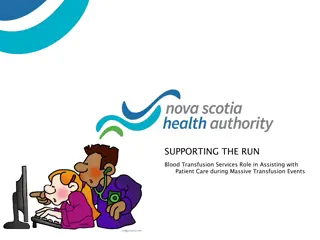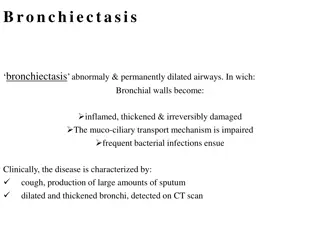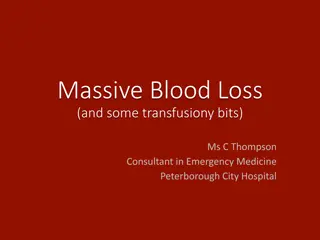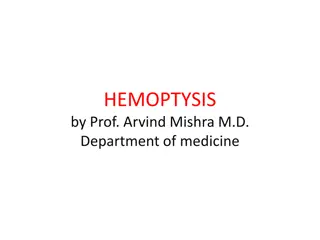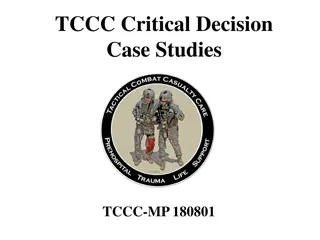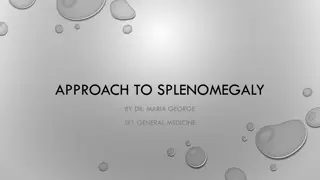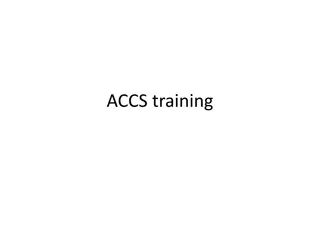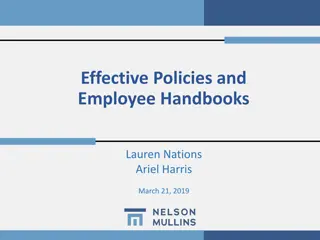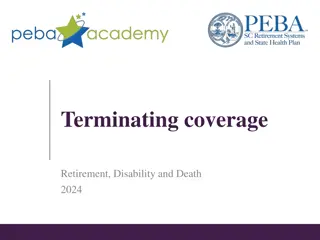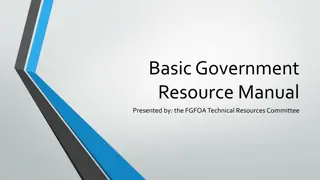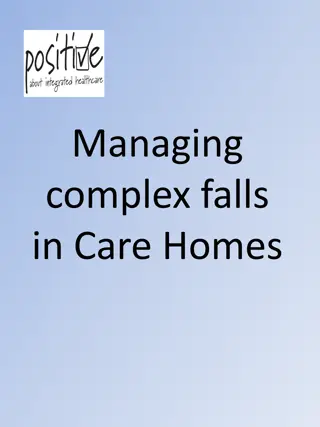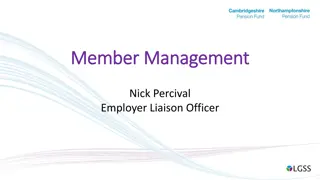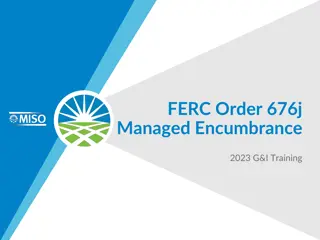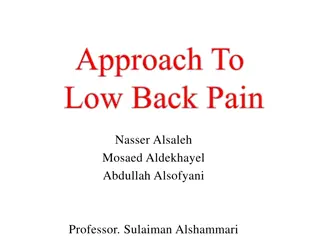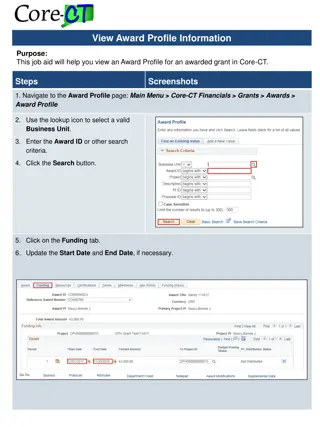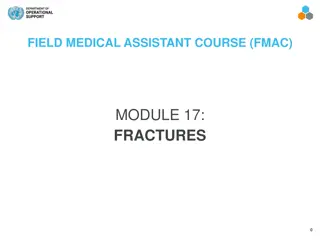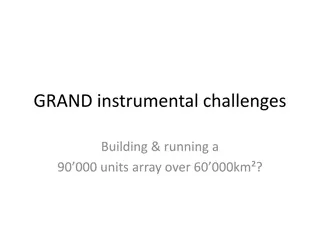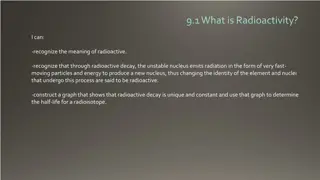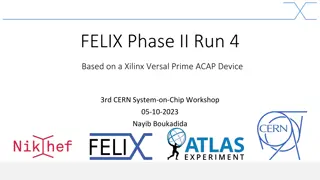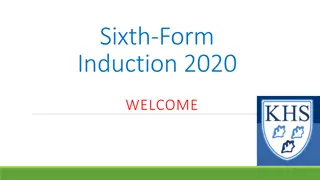Managing Massive Haemoptysis and Desaturation: A Comprehensive Guide
This detailed guide covers the fundamentals of massive haemoptysis, including its causes, management options, and complications. It emphasizes the importance of staying calm and following proper protocols to address life-threatening situations effectively. From understanding the blood supply of the lungs to localized treatment strategies, this resource equips medical professionals with valuable insights for managing critical cases of haemoptysis.
Download Presentation

Please find below an Image/Link to download the presentation.
The content on the website is provided AS IS for your information and personal use only. It may not be sold, licensed, or shared on other websites without obtaining consent from the author. Download presentation by click this link. If you encounter any issues during the download, it is possible that the publisher has removed the file from their server.
E N D
Presentation Transcript
Massive haemoptysis and desaturation Or how not to panic when it goes red Dr Diana Aguilar - February 2017
Overview 1. Blood supply of the lungs 2. Massive haemoptysis a. Definition b. Causes c. Management options 3. Complications of bronchoscopy a. Prevention of potential complications b. Management of bleeding and other complications
1. Blood supply of the lungs 90% of cases of massive haemoptysis Bronchial artery Bronchial vein Pulmonary artery Pulmonary vein
Bronchial arteries They supply Lungs Visceral pleural Oesophagus In chronic inflammation: Enlargement and proliferation of bronchial arteries Recruitment of vessels from the systemic circulation Thin walled arteries and more likely to rupture
2. Massive haemoptysis No established definition, 200-600ml in 24 hours Rate more important than volume Any bleeding that impairs ventilation and gas exchange Bronchial artery in aprox. 90% of cases Death due to asphyxiation rather than exsanguination Mortality around 20%, but up to 80%
Causes Massive haemoptysis Non-massive haemoptysis Bronchiectasis AVM Bronchogenic carcinoma PE Mycetoma Pulmonary hypertension Lung abscess Vasculitis Tuberculosis Eroding cavity Rasmussen Aneurism (PA) Trauma Mitral stenosis Iatrogenic
Goals of management Resuscitation Localisation Control Monitor 1. Airway, breathing, circulation Consider need for intubation and double lumen ETT Oxygenation Nurse the patient with bleeding side down (if known) Cough suppression may help (morphine, codeine) IV access, clotting, platelets, X-match Tranexamic acid
2. Localise the source History and examination (?epistaxis/?haematemesis) Imaging CXR can be normal (20-26%) if source proximal CTangiography bronchial artery Bronchoscopy (50-93% sensitivity) but can be challenging Safer after intubation Large bore suction channels Rigid bronchoscopy preferred if skills available
3. Control the bleeding: Isolate bleeding side if bleeding threatens other lung Double-lumen ETT Tamponade via balloon catheter (Fogarty)
Bronchial artery embolisation Localise and control the bleeding The most effective 70- 90% 20% risk of re-bleed Complications: Spinal cord ischaemia Chest pain Dysphagia Case courtesy of Prof O Hennessy, Radiopaedia.org, rID: 33694
Surgical approach Best approach if embolisation not possible Spirometry (<50%) best predictor of surgical risk Most suitable treatment/curative for: Localised bronchiectasis AVM Aneurysm Aspergilloma Hydatid cyst Mortality 20-30%
Future options Surgicel/Surgifoam: Local tamponade Isolation at the segmental or sub-segmental bleeding site Absorption of blood Promotion of endobronchial clot formation by induction of fibrin polymerization.
4. Monitor in HDU/ITU 5. Consider palliation:morphine, diazepam If all measures fail If it is inappropriate to resuscitate the patient (advanced disease, Advance Directive, etc) Support and communication with patient, relatives and junior staff, can be a traumatic experience.
3. Complications of bronchoscopy Planning and prevention: Thorough patient assessment pre-bronchoscopy: Indication: is it appropriate? If previous bronchoscopy: Were there complications? Dose of sedation needed Consent Results: clotting, platelets, renal function, FEV1 Medications: anticoagulation, antiplatelets Comorbidities: asthma, COPD, DM, BMI, arrhtyhmias Available personnel and equipment (OOH FOB)
Complications Respiratory depression Bronchoconstriction Hypoventilation Hypotension Syncope Bleeding (severe bleed <1%) Endobronchial biopsy: platelets > 50,000/ L More complex procedures, platelets > 75,000/ L. Routine oxygen and CVS monitoring are essential in alerting of a deterioration
Bleeding during bronchoscopy Suctioning Iced saline irrigation Laser coagulation Adrenaline Argon plasma coagulator (APC) Bronchoscopic tamponade Electrocautery Balloon tamponade Fogarty balloon Double-lumen ETT tube Thrombin or fibrinogen instillation
Other complications Hypoxia: usually resolves with oxygenation and termination of the procedure. Brochosconstriction may require termination of procedure Respiratory depression, consider need for: NIV rescue Flumazenil (should be a Never event , so cautious sedation in at risk patients) Syncope: standard observations, ECG, BMs, etc
Summary Massive haemoptysis is a medical emergency Step-wise approach: Resuscitation Localisation Control Monitor Team work to help you: * A&E * ITU * Endoscopy team * Palliative care You * Radiology * Experienced anesthetist * Thoracic surgeons The patient & Thorough preparation pre-bronchoscopy Respiratory Spr saves the day!
When it goes from this .to this to this


